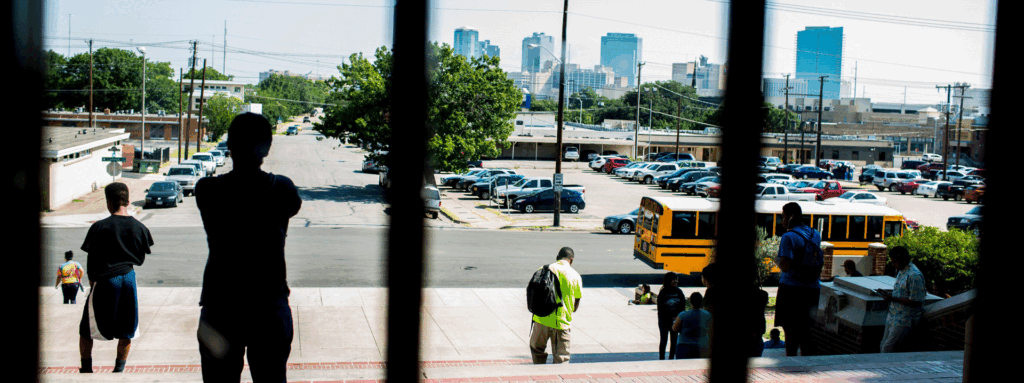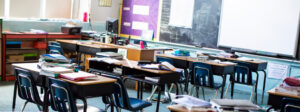We last spoke with Cami Anderson to better understand how Newark Public Schools—where Cami was superintendent for four and a half years—overhauled its compensation system to pay great teachers what they’re worth. After her long tenure as a teacher, social entrepreneur and district superintendent, Cami is now undertaking a very different kind of challenge: She’s launching the Discipline Revolution Project, a coalition of education reformers, from district and charter schools, who want to come together to consider how to change our approach to school discipline and disrupt the school-to-prison pipeline.
What brought you to this issue? Why do we need a “revolution” when it comes to school discipline?
First, just look at the data. Fifty percent of school-based arrests are of African-American kids, but African Americans make up 15 percent of all students. Students with disabilities are between three and four times more likely to be suspended for the same offenses as their peers. LGBTQ students are disproportionally punished. In addition to being grossly unfair, this also has long-term consequences for kids and for schools: Students who are suspended are three times more likely than their peers to drop out of school, and three times as likely to be incarcerated. And that’s just the beginning of a life with limited options—in some cases spurred by well-meaning but completely misguided and inequitable school discipline policies and practices.
[subscribe]
Despite these hard facts, changing school discipline hasn’t really been on the radar of education reformers. Collectively, we haven’t seen it as a priority or acknowledged our urgent responsibility to stop committing civil rights offenses, like those we lament in biased and life-ending juvenile and criminal justice systems. We’ve failed to see the connection between effective school discipline practices, improved and culturally competent school cultures, and—combined with rigorous content and great talent practices—radically improved student outcomes. We haven’t confronted the terrible consequences of punitive discipline, as well as the potential upside of doing things differently. We haven’t seen the shift away from antiquated discipline practices as mission-critical to our broader mandate to ensure excellence and equity for all kids.
This is also very personal for me. I was the superintendent of alternative high schools in New York City for five years. Among many things, my portfolio included schools for kids who were incarcerated, as well as the one-year suspension centers. It was pretty hard to ignore the stark fact that we were serving almost exclusively African-American and Latinx boys, as well as a few African-American and Latinx girls—even though that does not represent the demographics of the city.
I would look at the kids’ files to see why they were there, and would see things like a three-month suspension for “using a rubber band as a weapon.” I also saw that these young people don’t tend to graduate. The idea is that they’re supposed to go to the suspension centers to get all these services and then come back to school. But they don’t get the services and the stigma is impossible to overcome, so they come back behind. I saw the same kids on Rikers Island that I saw in the suspension centers, all the time.
What’s the plan for the Discipline Revolution Project? How are you trying to help?
I think there’s growing recognition in the education community, both from charter and district leaders, that we’ve helped create the school-to-prison pipeline and it is up to us to dismantle it. But we can’t just be against biased, punitive discipline without articulating what we are moving toward. We’re in a moment when many leaders are eager to tackle this issue, but they don’t have easy access to resources or practical ideas to figure out where to start. So I think there’s a real opportunity to push the conversation forward and do so in a way that helps people embrace practical, albeit difficult, new approaches.
We’ve created what we call a “discipline equity framework,” which summarizes the best of what we know in anti-bias, culturally responsive work, trauma-informed work, and social-emotional learning and supports. The Discipline Revolution Project is about much more than changing discipline policies—it is about empowering and inspiring young people to develop healthy habits and be their best selves by ensuring they connect with empathetic, skilled adults who personalize their approach to student support and learning. It’s also about helping adults respond to incidents in ways that help young people learn from their mistakes and build strong peer cultures of accountability with love.
We’ve summarized complex research and promising practices we’ve seen in action so principals, district leaders, CMO leaders, funders, advocates, and other school-based partners can download all of it in one place. We’re learning that there’s a lot of need for ongoing support and technical assistance. We’re in the process of building more infrastructure so we can do more research and provide deeper training and technical assistance at the local level. I really think education reform leaders are eager to get out of the finger-wagging space to work across traditional lines that divide us—particularly charter versus district—to solve problems around equity that plague us all.
Do charter schools have a particular role to play in this revolution?
100 percent, no question. Charters and charter networks are critical to this dialogue because they have more flexibility regarding staffing, money, and ability to move quickly. For example, there are at least three networks I can think of that are completely re-thinking their approach to school culture. They’re thinking deeply about all the things they have done around schoolwide rituals and rules, and how they might be missing the mark. They’re working to encourage students to take ownership over their actions, and are asking students about whether they feel loved and understood by their teachers.
Now, we should be clear that traditional district schools need to grapple with this problem every bit as much as charter schools do. And just like in almost every other aspect of running a school, some charters do a better job than others, just like some districts do a better job than others. So it’s not an issue of culpability. But I do think the charter sector is uniquely suited to try new, innovative approaches to discipline and student supports that we need, and that’s why I think it’s so important they’re at the table and leading.
Based on all the research and promising practices you’ve seen, what’s the basic shift you think schools need to make on discipline?
With discipline, our instinct is to admonish or punish a kid if they’re not compliant. Punishments can be big things like suspending a kid for a week, or small things like checkmarks and verbal reprimands every time a student steps out to the right or the left.
We want to move toward thinking of discipline as a way of practicing something until you master it—more like a disciplined athlete or artist. In that context, “disciplined” means someone who tries and works hard in a structured, focused way that shows perseverance and commitment.
We want adults to teach kids purposeful habits, as opposed to teaching compliance. At a macro level, that’s going to push us to do all sorts of things differently—not just discipline. It’s going to force us to think about how we support adults in schools to build deep, trusting, and empathetic relationships with kids. Empathetic relationships between adults and students have been proven to be one of the best indicators of success for children. This requires adults to deeply understand what makes each kid tick, what triggers them, and what motivates them to change and grow.
Frankly, shifting away from punitive discipline will force us to get better at encouraging kids to build the skills they need to succeed in the long term. We have to acknowledge that kids are going to challenge authority; that’s sort of their job. We have to respond with developmentally appropriate, purposeful actions—so the kid is held accountable in a way that helps them learn and grow, as opposed to just learning that they should continually buck authority, or that compliance is the only way to be in good graces with adults.
So this is as much a shift in philosophy as a change to any particular practices.
Right, that’s where the “revolution” idea comes from. We need to change the way we’re thinking about discipline 180 degrees, not 10 or 20 degrees.
Can you talk more about what restorative practices are, and how they fit into this?
Originally, restorative practices were rituals that brought together the person who perpetrated a crime with the victims of that crime. Restorative practices were leading to pretty amazing results in terms of recidivism rates, but also in terms of the well-being of both the victims and perpetrators of crimes. Some police departments started experimenting with these practices, and eventually some schools.
There are schools in Newark that use restorative practices, not just with young people, and not just in classrooms, but also at community forums. In our high schools, we brought in proctors, school safety agents, student leaders, teachers, administrators and others together to be trained on restorative circles and restorative practices, so that everybody was singing from the same songbook in terms of how they were approaching the work. It had a tremendous impact on more than the obvious things like violent incidents and reduced suspensions, but also on some of the intangibles, like how people treat each other.
Having said all that, it’s only one part of what needs to happen for us to move away from punitive discipline. There’s a whole host of other things, like how teachers build relationships with students. And of course, the best way to prevent misbehavior in the first place is high-quality, relevant, and engaging lessons.
Can you give some examples of positive changes you’ve seen?
I’ve seen several schools, charter and district, form student support teams with adults with different skill sets, like social workers, teachers, administrators, and peer coordinators. These teams create a safe place for kids to talk before they reach the point of crisis.
There’s also an increasing number of schools doing culture and climate audits, asking students about their experiences and using that data to make changes. Districts are also rethinking the language they use to recruit teachers, to ensure that they’re sending the message that teaching is about building deep and trusting relationships and coaching kids on their non-academic skills as much as their academics.
I’ve also seen some great therapeutic learning centers, which are safe spaces where kids can go and participate in affinity groups, counseling, and student-led discussions. I’m optimistic about what we can achieve in this area because I’ve seen the needle move already.
[related]
But again, this is much bigger than implementing any specific practice. When you take a hard look at the data on school discipline, you see that it’s an overlooked symptom of a familiar problem: There’s a whole group of kids that, despite our best efforts, we are not serving well at scale. They tend to have one, if not all, of the following characteristics: They’re students with disabilities, students who are homeless, students living in extreme poverty, students who are growing up in foster care, students who have a parent who is incarcerated, or they’re connected to the child welfare system in some way. We like to say we’re working for “all kids,” but we don’t always act in ways that are inclusive of our student populations or that help all students excel.
Even the best among us—the best superintendents, the best charter operators—if you just look at the data, that’s the reality. I believe that while we’re calling this the Discipline Revolution Project, it’s really about School Reform 2.0. I think it’s going to show results with a group of kids that we continue to fail.





